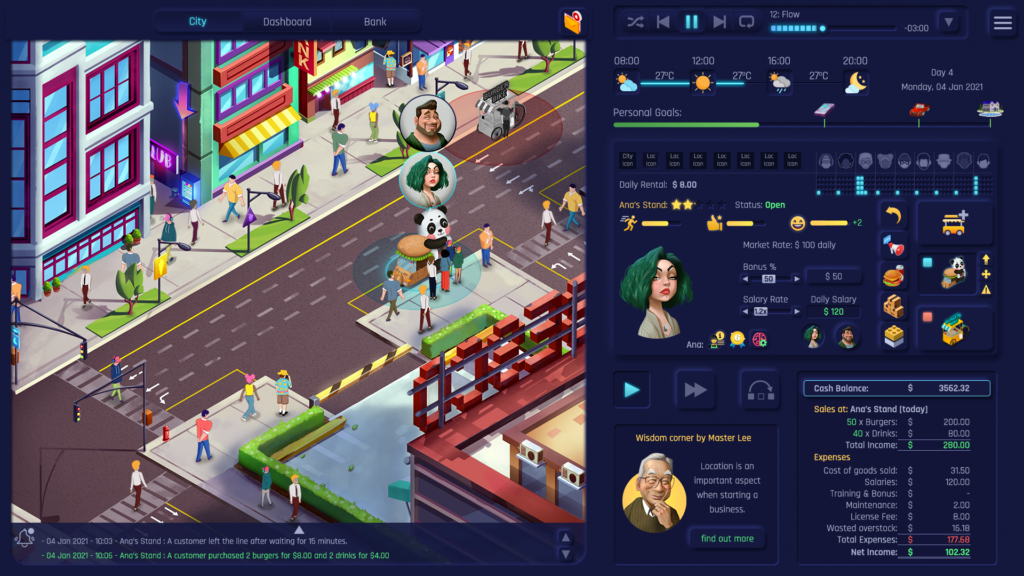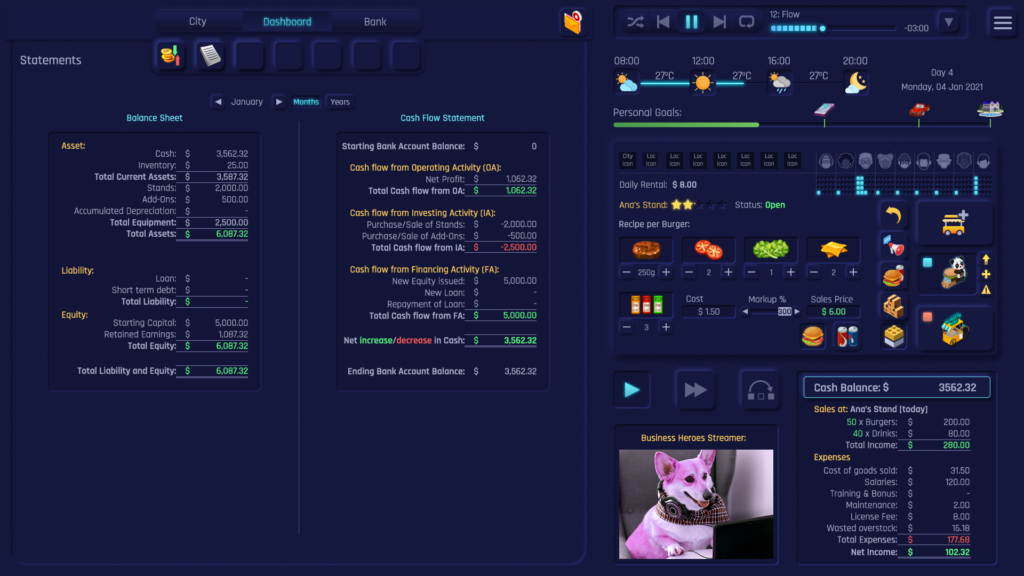Posts In: Development log
28 January 2021
Life Lessons Learned from Developing Business Heroes – A PC Game

Welcome to the first Business Heroes development log of the year! Hopefully, your year is off to a great start. Someone once said those who don’t remember the past are those condemned to repeat it. So, we thought we’d start the year looking back on our journey developing the Business Heroes PC Game, how we started, where we are, and lessons learned.
As you may know, Business Heroes: Food Truck Simulation is an exciting turn-based business simulation PC game about growing and managing the operations of a business that sells burgers and drinks. You can read more about our motivation for creating the game and Wishlist it on Steam.
Our journey started in April 2020 with a lot of research, brainstorming, scoping, and planning. Our goal for the game at this stage was, and still is, fun. We wanted our players to have fun while experiencing the thrills of running their own business.
Lesson: Always strive to have a clear goal and vision. Develop a plan and understand that it will change as you move towards your goal.
Two months later, we had a plan. We knew what the game would look like, how it would feel to play, and what the mechanics would be. In June, we set two main targets. We aimed to run a December Kickstarter in 2020 and release an Early Access version of the game on Steam in February 2021. We started production that month and diligently developed the game based on the vision we had for it.

Lesson: In life, you’ll never discover certain information until you set out on your journey with clear milestones for yourself. Don’t wait to know everything. Prepare as thoroughly as you can, then just start.
Well, three challenges soon made us realize that our targets were way too optimistic.
We encountered the first challenge after engaging with our audience and discovering that they were expecting much more from the game in terms of complexity and engagement. This discovery was only possible because we were marketing the game while developing it. Our audience started giving us feedback early.
Lesson: It’s always good practice to get the perspective of those you create for during the creation process.
The second challenge had to do with our User Interface design. Sometime in November, we realized that our game User Interface was not accessible and inclusive enough for all players. Primarily, we wanted to ensure that people with vision-related disabilities would play the game without experiencing any challenges. Another aspect of the User Interface design we had not considered was the impact language translation would have on the Interface text. Considering that there is much text in the game, and we will be releasing the game in several languages, this was a significant problem.

Lesson: This User Interface discovery taught us the value of adopting accessibility and inclusion in all we do. Being more considerate of the challenges others might experience because of their location, language, and/or disabilities helps everyone long-term.
The third challenge had to do with a conclusion we reached after researching Early Access reviews sometime in October. We realized that we would have a much greater chance of success if we released a very polished and bug-free Early Access version. This way, early adopters who play that version will see that the game will be amazing when it’s out of Early Access.
Lesson: What’s essential in life is to keep moving in the direction of your vision. Keep learning. It’s the only way to know when you need to course-correct and avoid crashing.
To give us time to fix these challenges, we decided to move the Early Access release forward. We have made substantial progress since then, and currently, this is how the game looks:

In the coming months, we will be working on Character AI, Pathing and Animation, AI Player, and Multiplayer integration. We’d be sure to keep you posted. You can follow us on social media for instant updates.
Please support our development and campaign by sharing our journey with friends and colleagues who might be interested in Business Heroes or the lessons we’ve learned while developing it. As you can see below, your support is the energy that fuels our ability to deliver outstanding results.

Follow For More

How customer preferences, needs, and unique recipes impact your performance in Business Heroes: Food Truck Simulation
Hey there! Welcome to this edition of our development log. This edition will reveal a little about your customers in business heroes and how they behave.
Business Heroes: Food Truck Simulation is a single & multiplayer, turn-based, food truck business simulation game. The goal is for players to fulfill their entrepreneurial dreams by growing a successful food truck company that sells burgers and drinks. You begin by choosing a capital city to play in. Then, armed with a single food cart, you start growing your business
When we started developing the customers for business heroes, we kept one goal in mind: to give you a sales experience that was as close to real-life as we could. Business owners in the outdoor food industry frequently interact with a broad range of people with different tastes and preferences. We wanted you to have the same business simulation experience in business heroes, so we designed the customer segments to reflect this.
Customer Segments
Because catering to all tastes and preferences would be impossible, we decided to focus on customer segments that could easily be differentiated. As you grow your burger truck business, you will be selling to Students, Parents, Tourists, Staff, Fit Ones, Managers, Influencers, Foodies, and Environmentalists.

These are not just meaningless labels. We designed them to reflect different tastes and preferences. Each group is particular about what matters most to them, and how your business can provide products and services that match their lifestyle and eating times.
Preferences
For example, students may be more concerned with the product’s price than how healthy or nutritious it is. On the other hand, the Fit Ones may be more concerned about the burger’s quality than with it being relatively low cost. Parents may prefer a burger package with more sauces because they want more value and would love to have leftovers for future use in their recipe.
Environmentalists generally would be wary about too much cheese and meat. They may prefer to pay more for a burger with more salad that tastes great, even though technically, it costs you less to make.
Because they are on vacation, tourists would generally indulge more. They may prefer more cheese, sauces, patty, and less salad in their burgers. They might also be predisposed to paying more for it.
Location & Customer Segments
An essential part of your success would be your ability to understand your customers’ needs and create custom burger recipes that meet their needs. The game has 7 locations where you will be trading. To make things slightly more manageable, we distributed, quite fairly, the various customer segments among these locations in the game.
For instance, a location like the Financial District has more managers, staff members, and environmentalists. In contrast, you will generally find more tourists and Trendsetters at the National landmark.

When you set up your stand in a location, some customers get attracted to you. Depending on the customer segment, they will look at your waiting line and decide to leave or stay.
Students who usually have more time than money may choose to wait longer than Managers, who typically have more money and less time.
Unique Recipes & Customer Feedback
You can customize your meat patty’s weight depending on the market segment you intend to target. You can also determine the amount of lettuce, tomatoes, sauces for each recipe. At the beginning of the game, we implemented an ecological option to enable players to run a vegan burger business if they wanted. We hope this gameplay option will make the game more inclusive for our vegan players.

After customers buy your product, they give you feedback immediately. If your burger meets their requirement as a segment, then they give you great feedback. If not, their feedback is negative. You can instantly adjust your recipe based on this feedback. Recipe adjustment is one of the decisions you can make during the day. You have to make most of your other choices at night.
Customer feedback will reflect on your overall stand reputation. The higher your reputation, the easier it is to attract more customers. As you grow your reputation and brand, your stands will attract more customers/passersby from farther away. These customers will decide to try out your burger, and depending on how strong your brand/reputation is, they may choose to wait a bit longer if there is a line. You can invest in advertising to boost your brand in the locality.
Successful players will discover how to balance the perfect recipe for their customers with timely investments in advertisement and staff training to reduce customer queues.